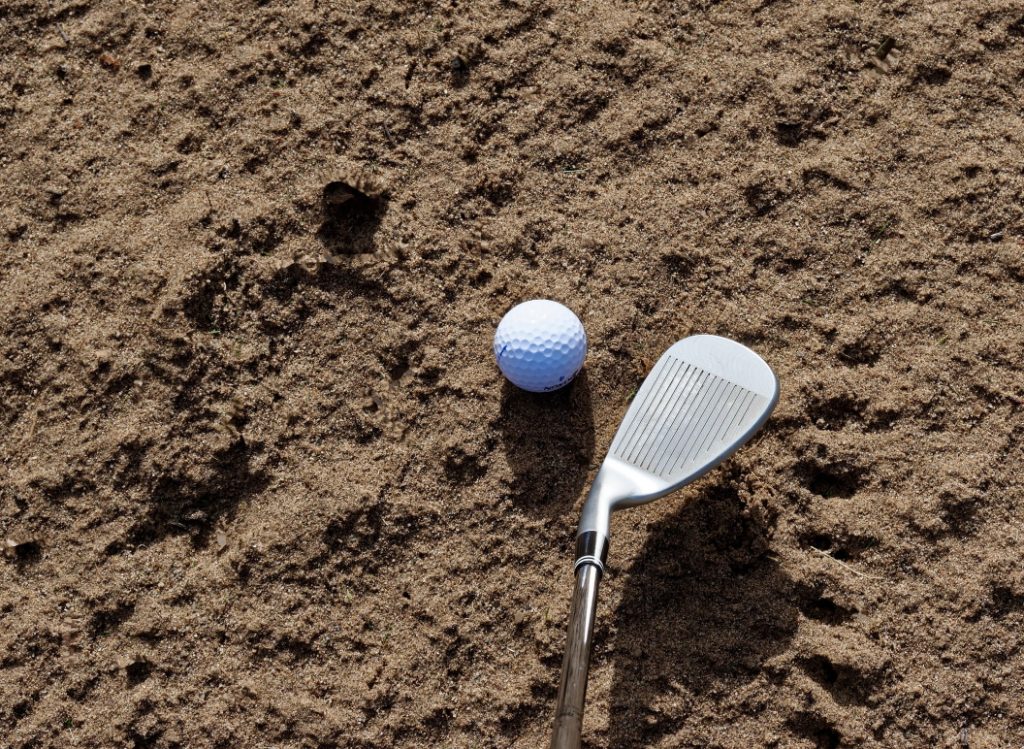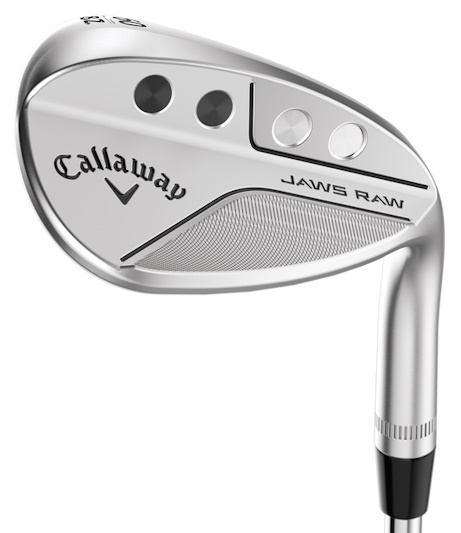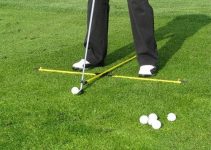Golfstead is reader-supported. When you buy through links on the site, we may earn an affiliate commission at no extra cost to you. Our affiliations include, but are not limited to, the eBay Partner Network and Amazon Associates.

The sand wedge is the second most common wedge used in golf after the pitching wedge. It’s a versatile wedge that can be used not only out of the sand, but also from the rough, from the fairway, or for chipping around the green.
How to hit a sand wedge depends on the particular situation: where you are (sand, rough, fairway), what your lie is (tight, fluffy, sitting down, etc.) and what shot you want to hit.
When it comes to the short, lofted irons like the sand wedge, pitching wedge or lob wedge, the concept for hitting them in each situation is basically the same.
In this article, we’ll give some background information about the sand wedge and discuss how to hit it in a variety of different situations.
What is a sand wedge?
Although the sand wedge is so named because it’s typically used to hit bunker shots, it is essentially just an iron with a clubface loft of around 54°-56°, which is generally in between a gap wedge and a lob wedge. The sand wedge also has a shorter shaft than longer irons, at about 33-37 inches.
A sand wedge generally has a wider sole (the surface at the bottom of the club) and has more bounce than other irons.
The term bounce is technically the angle between the leading edge and the trailing edge when the sole is resting on the ground. It refers to the quality or feature of an iron that allows it to “skim” the ground near the bottom of the swing arc.
In the case of the sand wedge, bounce typically ranges anywhere from 8°-14°.
With higher lofted clubs, the leading edge is more elevated than the trailing edge and thus is less able to dig into the ground. This is ideal in situations where we want to slide the club underneath the ball, launching it higher and having it land softer.
The Techniques
From the short grass (fairway, fringe, etc.), a sand wedge is played more or less the same as any other iron. The loft of the club will allow it to slide under the ball more and send it on a higher trajectory.
Some typical situations where a sand wedge is viable are:
- the ball is in the sand (of course)
- the ball is sitting in muddy ground, and/or is sitting down in the rough
- the ball is on firm grass and you want to hit a higher, softer shot
From The Sand

If you have a good lie in a greenside bunker that contains dry, fluffy sand, it’s recommended to use a sand wedge and play it like you would any normal bunker shot.
Enter the sand about a couple inches behind the ball, and let the bounce of the club slide the clubface underneath the ball, pushing sand upward and hence lifting the ball into the air. If you have trouble hitting behind the ball, try moving the ball forward in your stance.
This is not the only scenario, of course. You may have a buried lie or be playing out of wet sand that is packed down. In these kinds of cases, it’s best to use an iron with lower bounce such as a pitching wedge or even a 9-iron in order to help get the leading edge underneath the ball.
See my how-to article on hitting out of the bunker for more details and tips on hitting out of greenside bunkers.
From The Rough
When your ball is in longer grass and sitting down, you want to avoid “chopping down” on the ball with the leading edge and digging your club into the ground.
With a sand wedge, the goal is to use the bounce and focus on working the club through the rough into the ball.
Take the club far enough back and make a full enough swing so that you have enough momentum to get the club through the grass. If you don’t, the grass will catch and slow your clubface and you will likely make bad contact with the ball.
Also make sure you rotate fully through your shot, as not doing so will tend to promote stopping the club in the grass and digging.
See this great short video on hitting lofted clubs out of greenside rough by golf instructor Ken Green:
A sand wedge is also often a great choice when you have a fluffy lie in the rough where the ball is sitting up. In this situation, the higher bounce of the sand wedge helps the club slide through the grass rather than dig into the ground.
From The Short Grass
Although hitting your sand wedge from the fairway is very similar to hitting any other iron, there is one key difference between the sand wedge and your other irons that presents some difficulties for many golfers.
With a sand wedge, the leading edge of the club is significantly higher than the trailing edge — more so than most other clubs in the bag. This can cause the sole of the club to touch the ground before the leading edge, and you end up hitting the ball thin or even topping it.
One way to get around this problem is to move the ball back in your stance. The end result of the new address position is your hands being more forward from the clubhead.
This does deloft the clubface slightly, but it also brings the leading edge down to the ground and elevates the trailing edge, thus solving the problem you were facing. It also makes it easier to hit down on the ball.
With this slightly altered setup, you can effectively make a normal swing and be more confident that you will make proper contact.
When A Sand Wedge Is Not Optimal
The biggest thing with sand wedges is that they have high bounce. While high-bounce wedges can be used in the majority of situations out on the golf course, they’re not always the best choice.
For example, if you have a naturally shallow swing and tend to take little or no divot, a sand wedge may not work well for you because the high bounce will lead to an even greater risk of a bladed shot. A wedge with less bounce would be the better choice.
Also, it’s normally not recommended to use a high-bounce wedge like a sand wedge off of tight, firm lies. There are ways to pull it off as we covered in the previous section, but it’s not really ideal because the bounce tends to bring the leading edge up and into the side of the ball.
In any case, when determining which wedges work best for you, you need to figure out what lofts and bounce settings best suit your particular swing. Weekend hackers don’t need to worry about this too much, but serious golfers should make efforts to get it right as it can make all the difference when trying to shoot a lower score.
If you don’t want to go through a custom fitting, try buying a quality wedge that has multiple loft and bounce settings, and experiment until you find a setting that works best for you. You can even take it up a notch by looking into different grinds.
Final Thoughts
The proper technique for hitting a shot with a sand wedge ultimately depends on the lie and the shot you want to hit. Fortunately, its higher bounce makes the club relatively easy and straightforward to hit even for low-skill golfers.
With a sound technique and enough practice, you should be able to perfect your use of the sand wedge in a variety of different situations.
Remember that having quality equipment (clubs, training aids, etc.) will not only help you hit your sand wedge well, but also help lift up your entire game.
Thanks for reading. Are you learning how to hit a sand wedge or are struggling with it? Feel free to drop your thoughts in the comments below.





Glad you found it useful, Matt. Many people surprisingly don’t even have a firm grasp of the basics — the goal was to cover them and more.
This is solid advice Paul. I used to really struggle with hitting my sand wedge, more so than other wedges in the bag (perhaps because of the different bounce properties that you mentioned). What I ended up doing was going back to the basics, and it made a world of difference.
You can try to emulate Tour players or overcomplicate things, but at the end of the day, it comes down to the fundamentals and what works for you. To anyone out there struggling to hit their sand wedge: try the straightforward tips in this article and see how it works out!
Agreed. Thanks Brian.